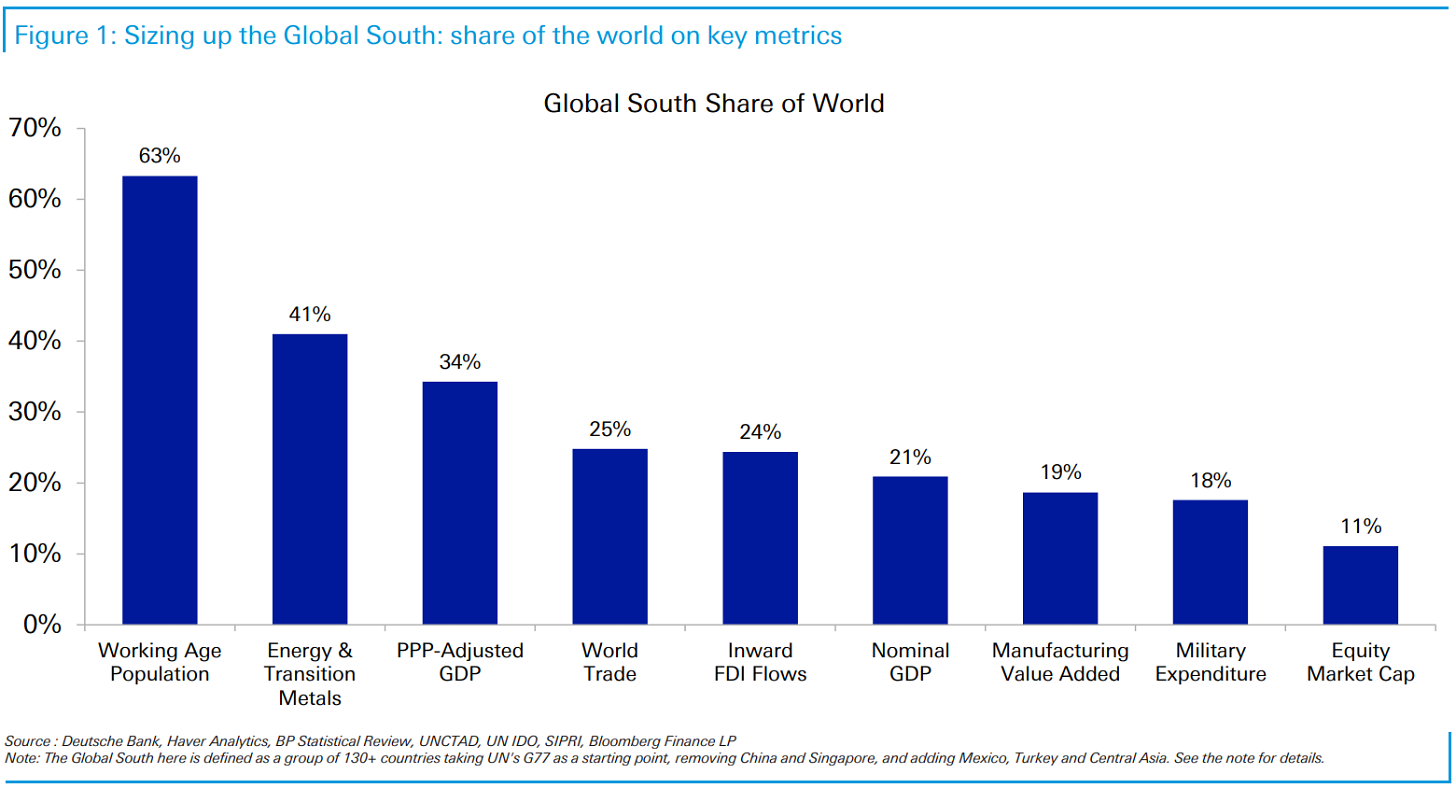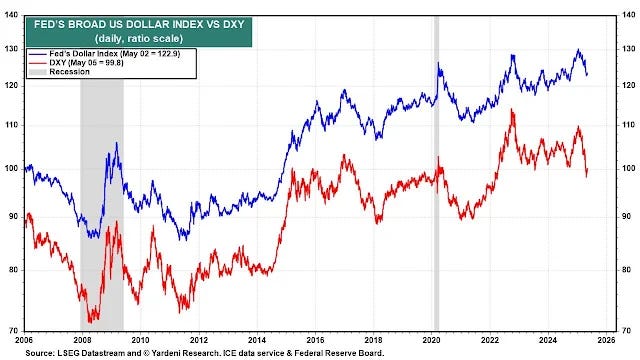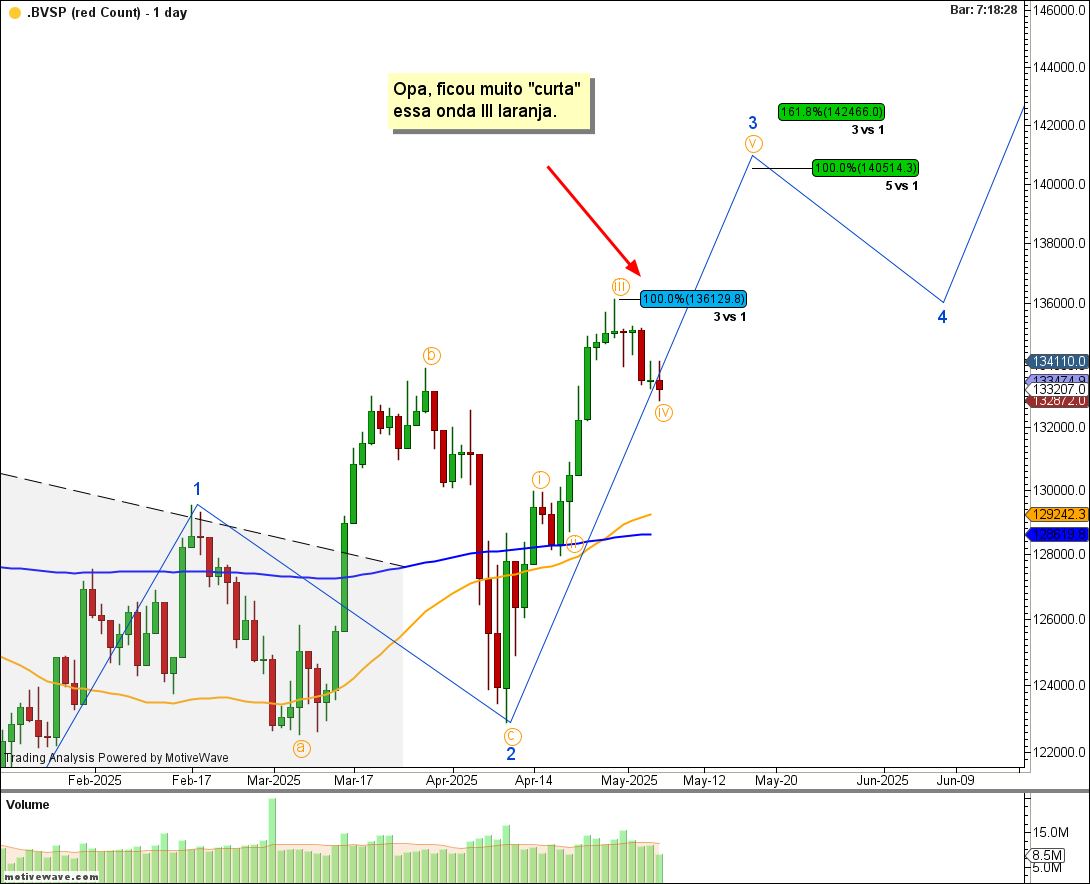The Rising South: The New Global Order
The world is in check. The trade war triggered by Trump is shaking up the structures of global trade, and Mosca sees a watershed: the Global South is emerging as the protagonist. While the historically rich and militarily dominant North holds power, the South, which is more populous and rich in resources, is gaining relevance. A study by Deutsche Bank, detailed in its Global South Scorecard, maps this potential: the South is home to 63% of the working-age population, 40% of energy and transition metal resources, and 33% of global GDP adjusted for purchasing power parity. However, it represents only 11% of market capitalization, a gap that signals opportunities.
India, Indonesia, Brazil and Saudi Arabia lead the ranking, benefiting from scale and resources. In a fragmented world, size matters: larger nations are more resilient to deglobalization. Deutsche Bank's analysis warns of the impacts of a trade shock. With the US retreating, China will be pivotal — either by absorbing exports from the South or reallocating production. Europe, in turn, is advancing, negotiating agreements with Latin America, ASEAN and India, positioning itself as a strategic partner.
The Fall of the Dollar
Much has been discussed about the recent depreciation of the dollar, and the reasons are diverse. This week, the Taiwanese dollar registered a significant appreciation, driven by the massive sale of dollar-denominated assets by Taiwanese insurers. With around US$600 billion invested in US bonds, these companies, facing losses due to the fall of the dollar, sold part of these assets and reduced currency hedges, strengthening the TWD against the USD. This move, which lifted the TWD by 6.5% in two days, reflects the vulnerability of portfolios not hedged against currency fluctuations and has intensified pressure on the dollar globally.
The DXY index, which measures the dollar’s strength against a basket of currencies (57.6% euro, 13.6% yen, 11.9% pound, 9.1% Canadian dollar, 4.2% Swedish krona and 3.6% Swiss franc), is a traditional barometer but can be limited by its concentration in developed-country currencies. Alternatively, the Federal Reserve Broad Trade-Weighted Dollar Index offers a broader view, weighting the dollar against the currencies of 26 U.S. trading partners, adjusted for bilateral trade volume. This index better captures the dollar’s dynamics in global terms of trade, including emerging economies, and is more sensitive to changes in international trade, such as Trump’s tariffs, which shake up the DXY and favor the Global South.
When to Press the Buy Button
In this second part, Mosca addresses the stock market, a battlefield where fortunes are made or destroyed, requiring more than just instinct. As Mosca has repeatedly said, buying a stock is not a trivial gesture, but a commitment that demands meticulous analysis. Technology has dissolved the barriers of the past — replacing telephone orders and newspaper consultations with instant data in the palm of your hand — but this accessibility has brought a greater risk: impulsiveness. A recent study, reported by the Wall Street Journal, exposes an alarming reality: the average investor dedicates only six minutes to research before buying a stock. In this fleeting interval, most limit themselves to recent price charts, often from the same day, as if an instant could reveal the fate of a company.
Mosca has always questioned simplistic metrics such as the price/earnings (P/E) ratio, widely adopted but intrinsically limited. Dividing a stock’s price by its projected earnings can indicate the time it will take to return on investment, but it ignores the cost of capital — a critical factor in markets like Brazil, where high interest rates prevail. Worse, the P/E assumes an unrealistic predictability of future earnings. If anticipating the next year is challenging, forecasting a decade is absurd. Even so, the WSJ study reveals that only 14% of those six minutes are spent on fundamentals such as earnings or dividends, and a measly six seconds — 1% of the time — on risk metrics such as volatility. In contrast, 73% of investors who consult charts focus on a single day’s performance, hypnotized by the illusion of the moment.
This is not investing; it is speculation disguised as strategy. Mosca has witnessed countless cases of investors seduced by “hot tips,” driven by a stock’s exposure in the headlines or by casual advice. The WSJ confirms: purchases guided by media attention rarely deliver exceptional returns. Quantitative analyst Nardin Baker is incisive: the best-performing stocks are generally the most prosaic, forgotten by analysts and journalists. By chasing the shine of rising tickers, investors pay inflated prices and reap mediocre results. The numbers don’t lie: stocks bought on impulse tend to perform worse than those sold, a pattern that Berkeley finance professor Terrance Odean associates with fixation on passing trends.
In the past, investing required effort. Mosca recalls a time of concrete obstacles: registering with brokerage firms, placing orders over the phone and checking results in the next day’s newspaper. Investing abroad was a bureaucratic saga. Today, apps have eliminated these frictions, but ease of use breeds negligence. The WSJ’s analysis of browsing data—more than eight million clicks in 60,000 hours of Internet use—proves that the web, with its unrestricted access to information, is the main resource for stock research. However, investors squander this advantage by prioritizing price charts over balance sheets or risk assessments.
So what should you do? Mosca advocates a firm stance against impulsiveness. Six minutes is not enough to map out the universe of stocks, much less to understand a company. Investing rationally requires examining fundamentals — earnings, dividends, debt — and risks, especially in poorly diversified portfolios. Odean recommends reducing the frequency of trading and basing each decision on rigorous research. The market favors the disciplined, not the hasty.
Mosca bases his approach on a combination of technical analysis, fundamentals and behavioral finance, with an emphasis on the Elliott Wave theory. This technique, developed by Ralph Nelson Elliott, postulates that stock prices follow repetitive patterns driven by the collective psychology of investors, reflected in waves of impulses and corrections. Identifying these waves allows you to anticipate market movements, but it requires precision and experience, as the patterns are not infallible. Complementing this analysis, Mosca prioritizes solid fundamentals and insights into market behavior. However, the essential pillar of his strategy is the stop loss, a mechanism that limits losses by automatically closing positions when the price reaches a predetermined level. Even the most robust analysis can fail, but the stop loss protects the equity from devastating drops, ensuring that mistakes do not turn into catastrophes.
Technical Analysis
Since today's topic is stocks, there's nothing better than commenting on the IBOVESPA: the index that would challenge even Warren Buffett to, at the very least, surpass the CDI! In the post “Workaholic is still the standard”, I made the following comments about the IBOVESPA: “For now, there are no signs that justify abandoning the trade, but the orange wave III was smaller than expected. This could happen, but it suggests caution, since the proportion between waves 1 and 3 being the same may indicate a correction, not a directional movement.”
The stock market has retreated a bit further and I hope it doesn't retreat much beyond the current 133.4 thousand points. Part of my interest in this asset comes from my readers, many of whom, like those at Investidor em Valor, closely follow the Brazilian stock market. To be honest, I'm not a fan of this asset — nothing personal, but since the commitment is to the wallet, there are better options. If this trade doesn't work out, you can testify that I tried. If we are stopped out and the stock market retreats significantly — if it does, I'll have to consider the head and shoulders formation. But there is still hope.
I am liquidating my gold position, more details tomorrow.
The S&P500 closed at 5,631, up 0.43%; the USDBRL at R$5.7450, up 0.57%; the EURUSD at €1.1302, down 0.58%; and gold at US$3,372, down 1.66%
Stay tuned!
Original Post: Click Here
This is not an investment recommendation.
About the Author of this Post: David Gotlib has 45 years of experience in investment management. An engineer from Polytechnic School of the University of São Paulo, he was one of the founders of the first Brazilian hedge fund in 1993 (AUM US$ 1 billion). Later, he was Managing Director of Deutsche Bank Asset Management (AUM R$ 2.2 billion) until the company was sold to Bradesco. He is currently the manager of his own investment portfolio and the author of the blog Acertar na Mosca, where, since 2011, he has shared his thoughts on the global economy and the financial market on a daily basis.








